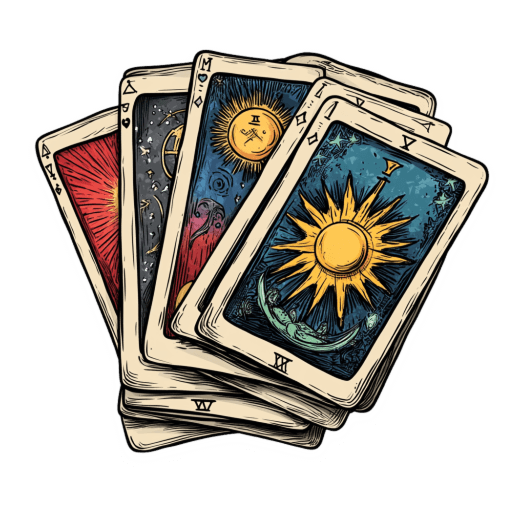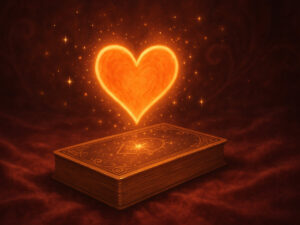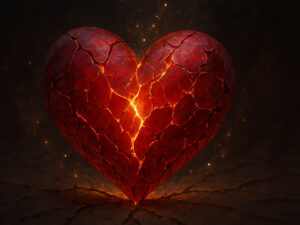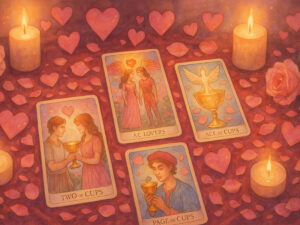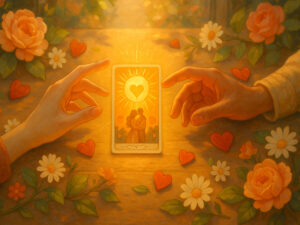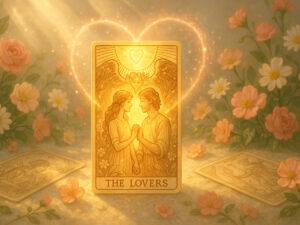Top Tarot Cards That Indicate Love Is Coming

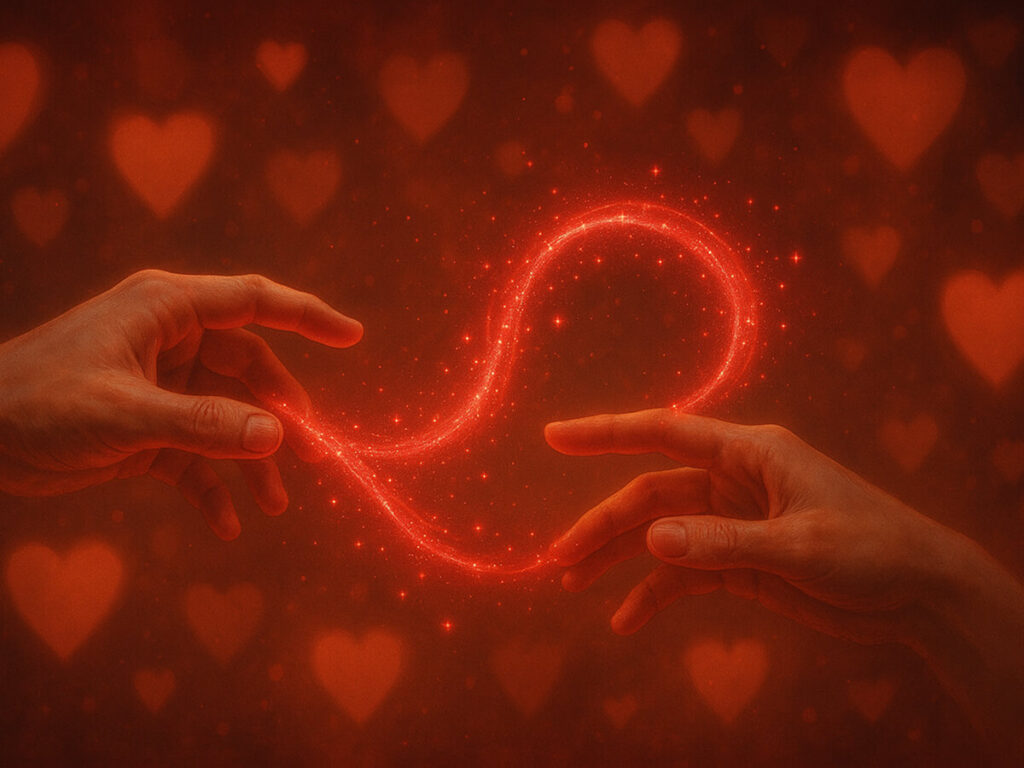
Table of Contents
Did you know that nearly 68% of tarot readers report that love and relationships are the most common topics clients ask about? I wasn’t surprised when I first learned this statistic from the International Tarot Foundation’s 2024 survey. After all, matters of the heart touch us all deeply.
I still remember my first encounter with love tarot cards. It was a chilly autumn evening in 1988, and a friend had brought over her worn deck, passed down from her grandmother. As she laid out the cards for me, I watched with skepticism that quickly melted into fascination. The Two of Cups appeared prominently in my reading, and within weeks, I met someone who would become a significant part of my journey.
That experience sparked my lifelong passion for understanding how tarot can illuminate our romantic paths. Over my four decades of practice, I’ve discovered that certain cards consistently appear when love is blooming, struggling, or transforming.
In this comprehensive guide, I’ll share the wisdom I’ve gathered about the most powerful tarot cards that indicate love. Whether you’re a complete beginner just learning to distinguish the Major from Minor Arcana, or an experienced reader seeking deeper insights, you’ll find valuable knowledge here.
We’ll explore not just the obvious love cards like The Lovers, but also unexpected cards that signal romantic connections. I’ll share practical techniques I’ve refined through thousands of readings, helping you avoid the common pitfalls I stumbled through in my early years.
The language of tarot speaks through symbols and intuition. Sometimes the cards whisper, and sometimes they shout—but they always have something meaningful to say about our hearts’ deepest desires. Let’s learn to listen together.
Remember, tarot isn’t about predicting a fixed future but illuminating possibilities and potential paths. As Miranda Starr, I’ve witnessed how understanding these cards can empower people to make conscious choices about their romantic lives rather than feeling at the mercy of fate.
Let’s begin our journey through the heart of tarot.
Understanding Love Tarot Cards and Their Significance
When I first began studying tarot in the early 1980s, I approached love readings with a simplistic view—looking for “yes” or “no” answers about potential relationships. I couldn’t have been more mistaken! The cards offer much richer insights than simple predictions.
Tarot and matters of the heart have been intertwined for centuries. Historical records from 15th-century Italy show that even then, people consulted tarot for guidance in romantic affairs. The symbolism within the cards speaks to universal experiences of love, desire, commitment, and heartbreak that transcend time and culture.
One fundamental distinction that took me years to fully appreciate is the difference between Major and Minor Arcana cards in love readings. The 22 Major Arcana cards typically represent significant relationship themes or turning points—think of them as the chapter titles in your love story. When The Lovers appears, it often signals a meaningful choice or commitment, not just a new romance as I once assumed.
The Minor Arcana, by contrast, fills in the details of daily romantic life. I’ve found that the Cups suit particularly relates to emotional experiences and relationships. During a memorable reading in 1994, I saw a client receive six Cup cards in a ten-card spread—her relationship was indeed emotionally rich but lacking in stability (Pentacles) and passion (Wands).
Position matters tremendously in love readings. The same card can tell a completely different story depending on where it lands in your spread. The Two of Cups in a future position suggests budding romance, while in a position representing obstacles, it might indicate emotional vulnerability is being blocked.
I made an embarrassing mistake early in my practice, interpreting The Devil card for a client as a warning about a dangerous relationship. In reality, it was highlighting the passionate but potentially obsessive nature of her connection. She later told me this insight helped her maintain the relationship’s intensity while establishing healthier boundaries.
When interpreting love cards, context is everything. Consider the surrounding cards, the specific question asked, and your intuitive response. The Eight of Wands alongside love cards often indicates swift developments, while the Four of Swords might suggest taking time for reflection before proceeding.
The most valuable lesson I’ve learned is that tarot doesn’t just tell us about potential partners—it reveals our own hearts. The cards you consistently draw reflect your emotional patterns and relationship needs. One client repeatedly drew the Nine of Pentacles, revealing her need for independence within partnership—something she hadn’t consciously recognized but immediately resonated with her experiences.
Major Arcana Cards That Reveal Romantic Potential
The first time The Lovers card appeared in my own reading, I nearly fell off my chair with excitement. I was certain my soulmate would appear the very next day! Three months passed with no romantic prospects in sight. This taught me an important lesson: Major Arcana love cards speak to significant themes and energies, not just literal events.
The Lovers represents much more than romance—it embodies choice, alignment of values, and authentic connection. In April 2002, I did a reading for a woman struggling to choose between two relationships. The Lovers appeared reversed, revealing her true challenge wasn’t choosing between partners but reconciling conflicting values within herself. Six months later, she returned to tell me she’d chosen a completely different path that honored all aspects of her needs.
The Empress carries powerful feminine energy of nurturing, sensuality, and abundance in love. When this card appears, it often indicates a period where love can flourish if properly nurtured. I’ve noticed The Empress frequently appears for clients who need to cultivate self-love before a relationship can thrive. One particularly memorable client received this card three readings in a row—only after she began treating herself with the care she reserved for others did her love life transform.
Don’t overlook The Emperor in love readings! While less obviously romantic than other cards, it signifies stability, commitment, and structure—essential elements of lasting relationships. A client once received The Emperor when asking about a new relationship that felt chaotic and uncertain. The card wasn’t suggesting the relationship would become controlling, as she feared, but rather that establishing clear boundaries would allow genuine security to develop.
The Sun is perhaps the most joyful card in a love reading, representing fulfillment, vitality, and authentic happiness. I remember a reading where The Sun appeared for a woman who had given up on finding love after multiple disappointments. Within weeks, she reconnected with an old friend, and their relationship blossomed into something remarkably positive and energizing for both.
The Star offers hope and healing in romantic matters. It often appears after periods of heartbreak or disillusionment, promising renewal. I’ve found it frequently appears in readings when someone is ready to trust again after betrayal. The card’s gentle energy reminds us that vulnerability, while frightening, creates the conditions for genuine connection.
These Major Arcana cards don’t guarantee specific romantic outcomes but illuminate the spiritual lessons and growth opportunities present in our relationships. When interpreting them, look beyond the immediate “Will I find love?” question to the deeper message: “What am I learning about love?” This perspective transforms tarot from simple fortune-telling into a powerful tool for romantic self-discovery.
Minor Arcana Love Cards in the Cups Suit
I’ll never forget the first time I truly understood the Two of Cups. I was reading for myself during a particularly lonely period in 1990. When this card appeared, I felt disappointed—it seemed too simple compared to the dramatic Major Arcana cards I’d hoped for. Three days later, I met someone at a bookstore who became a significant partner. The Two of Cups hadn’t promised a grand romantic narrative but accurately predicted a genuine heart connection.
This card represents the initial spark between two people—that moment of recognition and mutual attraction. Unlike the cosmic ordained connection of The Lovers, the Two of Cups speaks to emotional resonance on a human scale. When it appears, it suggests an opportunity for meaningful connection, though not necessarily a lifelong bond.
The Ten of Cups depicts emotional fulfillment and harmonious relationships. I’ve noticed it often appears not at the beginning of love stories but after couples have weathered challenges together. One client received this card after describing ongoing conflicts with her partner of eight years. Rather than dismissing her struggles, the card suggested that working through these difficulties could lead to deeper happiness. A year later, she confirmed they’d found a new level of emotional intimacy through couples therapy.
The Ace of Cups is perhaps the most promising card for new love. It represents emotional awakening and the pure potential of love not yet shaped by experience or expectation. However, I’ve learned that this card sometimes indicates emotional renewal within oneself rather than a new relationship. A memorable client received the Ace of Cups when asking about finding a partner, but the surrounding cards (Eight of Cups, Hermit) suggested her real journey was toward self-love and emotional independence.
The Knight of Cups brings romantic gestures and the pursuit of emotional fulfillment. In readings, I’ve found this card often represents either a person with these qualities or this energy entering the questioner’s life. The Knight can be wonderfully romantic but sometimes lacks staying power—a lesson I learned personally when ignoring other cards that tempered a Knight-dominated reading in my youth!
The Queen and King of Cups represent emotional maturity in relationships from different perspectives. The Queen embodies empathetic understanding and intuitive connection, while the King demonstrates emotional stability and wisdom. They frequently appear in readings for people ready for emotionally evolved partnerships. When both appear together—as happened in a memorable reading for a couple celebrating their 30th anniversary—it suggests a relationship where both parties have developed emotional mastery while honoring their distinct approaches to love.
Minor Arcana cards may lack the cosmic significance of the Major Arcana, but they provide nuanced insights into the daily reality of love. They remind us that grand romance is built through countless small moments of connection, understanding, and emotional honesty.
Unexpected Tarot Cards That Signal Love Connections
In my early years as a tarot reader, I fell into a common trap—looking only for the obvious love cards like The Lovers or Two of Cups. This narrow focus caused me to miss subtle but powerful romantic messages. One pivotal moment changed my approach forever: during a seemingly non-romantic reading about career, I noticed the Nine of Pentacles appeared prominently. Within months, my client met someone through her professional success, a connection that blossomed into marriage.
The Nine of Pentacles often goes unrecognized as a love indicator. Traditionally associated with independence and self-sufficiency, this card actually signals readiness for healthy love. It suggests someone has cultivated their own garden—literally and metaphorically—creating a fulfilling life that can be shared from a place of wholeness rather than need. I’ve observed this card appearing frequently for clients who find significant relationships shortly after establishing their independence.
The Four of Wands surprised me in love readings until I recognized its celebratory energy represents the foundation of lasting partnerships. Beyond just marking celebrations like engagements or weddings, it indicates the creation of a stable home—emotional or physical—where love can flourish. A client confused by this card’s appearance when asking about a new relationship later recognized it predicted their easy integration into each other’s friend groups and families, creating a supportive community around their love.
Many readers overlook The Hierophant in romantic contexts, associating it only with tradition or religion. However, I’ve found it powerfully indicates commitment and shared values in relationships. During a particularly insightful reading in 2003, The Hierophant appeared for a woman questioning her compatibility with someone from a different cultural background. Rather than suggesting insurmountable differences, the card highlighted their shared core values beneath surface differences—a perspective that helped them build a strong marriage bridging two traditions.
The World card in love readings often signals completion of a romantic cycle and the integration of lessons learned. I remember a client who received this card after describing a series of unsatisfying relationships. Rather than promising an immediate perfect partner, The World suggested she had gathered all the experiences needed to create wholeness in love. She later shared that this perspective shift helped her approach dating with wisdom rather than desperation.
Temperance easily gets overlooked amid more dramatic cards, but it powerfully indicates balance and harmony in love. One of my most memorable readings featured Temperance for a couple considering reconciliation after separation. The card didn’t promise easy resolution but suggested their willingness to blend different perspectives and find middle ground would create something stronger than before. Three years later, they reported that the “alchemy” of combining their different approaches had indeed transformed their relationship.
These unexpected cards remind us that love permeates all aspects of life, not just the obviously romantic realms. By expanding our awareness beyond traditional love cards, we gain a richer understanding of how relationships develop, transform, and integrate into our whole life experience. The most significant romantic insights often come from the cards we least expect to speak of love.
Reading Tarot Cards for Love: Practical Techniques
My first attempt at a love reading back in 1981 was, frankly, a disaster. I shuffled nervously, spilled cards everywhere, and then overwhelmed my friend with a 15-card spread that left us both confused. Through decades of practice (and plenty of mistakes!), I’ve discovered that simpler approaches often yield the most profound insights.
Let me share a straightforward 3-card love spread that has served both beginners and experienced readers well. Place the first card to represent the current state of your love life, the middle card for challenges or opportunities, and the third for guidance or potential outcomes. This simple structure provides remarkable clarity without overwhelming complexity.
I once did this reading for a woman who had been single for seven years. Her cards showed the Four of Cups (current state—dissatisfaction with options), followed by the Knight of Wands reversed (challenge—impatience and unrealistic expectations), and finally the Seven of Pentacles (guidance—slow cultivation of relationship possibilities). This simple spread helped her recognize how she’d been sabotaging potential connections by expecting immediate perfection.
The questions you ask profoundly shape your readings. I learned this lesson the hard way after repeatedly asking, “Will I find love?” and receiving frustratingly vague answers. More effective questions include: “What energy am I bringing to my romantic life?” or “What would help me create a fulfilling relationship?” These questions empower rather than making you passive in your love story.
Intuition plays a crucial role in love readings, but many readers—myself included, initially—mistake anxiety or wishful thinking for intuitive guidance. I’ve developed a practice to distinguish true intuition: when a card interpretation comes to mind, I pause and notice how it feels in my body. Authentic intuitive insights typically bring a sense of relaxation or “rightness” in the chest, while projections often create tension or excitement.
Reading for yourself presents unique challenges. In 1995, I completely misinterpreted a reading about a new relationship because I was seeing what I wanted to see. Now I recommend writing down your interpretations when reading for yourself, then reviewing them a few days later with fresh eyes. This practice has revealed my blind spots countless times!
Common mistakes in love readings include looking for guaranteed outcomes, ignoring challenging cards, and interpreting literally rather than energetically. I once told a client The Lovers meant she would meet her soulmate within weeks—an interpretation that was both presumptuous and ultimately incorrect. The card was actually highlighting her need to make an important choice about her approach to relationships.
Remember that timing in tarot is notoriously difficult. Rather than predicting when you’ll meet someone, look for cards that suggest readiness for love or actions that might open romantic possibilities. The Eight of Wands might indicate quick developments, while the Seven of Pentacles suggests patience and gradual growth in love matters.
With practice, love readings become less about prediction and more about gaining clarity on your romantic patterns, needs, and opportunities for growth. This perspective transforms tarot from a passive fortune-telling tool into an active guide for creating the love life you truly desire.
Red Flags and Warning Cards in Love Tarot Readings
I made a serious mistake in my early years as a reader—I sugar-coated difficult cards in love readings. When The Tower appeared for a client questioning her engagement in 1992, I hesitated to address the card’s challenging message. Six months later, she returned after a painful breakup, wishing I’d helped her prepare for the necessary ending that The Tower had clearly foretold.
This experience taught me that warning cards aren’t obstacles to happiness but guideposts preventing greater pain. They deserve our careful attention, especially in matters of the heart.
The Tower in love readings often indicates sudden revelations or upheaval in relationships. While frightening, this card typically appears when existing structures no longer serve authentic connection. One client received The Tower when asking about her seven-year relationship. Rather than immediately ending things, she initiated honest conversations about long-ignored problems. This controlled “demolition” allowed them to rebuild on a stronger foundation, though the process was certainly uncomfortable.
The Three of Swords speaks directly to heartbreak and emotional pain. When it appears in a reading about current or potential relationships, it warns of hurt that may come from triangulation, betrayal, or fundamental incompatibility. I’ve noticed this card often appears when someone is entering a situation with unrealistic expectations or ignoring evident problems. One memorable client received this card repeatedly when asking about a married man who had promised to leave his wife. The card’s persistence finally helped her confront the painful truth of the situation.
The Five of Cups indicates disappointment and loss in relationships, focusing on what’s been spilled rather than what remains. This card frequently appears when someone is carrying past relationship grief into new situations. In a reading for a divorcé re-entering the dating world, the Five of Cups revealed how his focus on past betrayal was preventing him from noticing promising new connections. This awareness allowed him to consciously redirect his attention to possibility rather than loss.
The Devil card in love readings warns of unhealthy attachments or power dynamics. Rather than suggesting a “bad” relationship, it points to patterns of codependency, obsession, or situations where physical attraction overrides serious incompatibilities. I remember a reading where The Devil appeared alongside the Two of Cups for a woman describing intense chemistry with someone. This combination suggested the connection, while genuine, contained elements of compulsion that required conscious management.
Reversed love cards often modify rather than negate their upright meanings. A reversed Two of Cups might indicate imbalance in emotional exchange rather than absence of connection. Similarly, a reversed Lovers card might point to misalignment of values rather than lack of love. Understanding these nuances prevents black-and-white thinking about relationship prospects.
Warning cards don’t necessarily mean “avoid this relationship” but rather “approach with awareness.” They invite us to consider what needs healing, balancing, or honest acknowledgment. In my experience, the healthiest relationships aren’t those without challenges but those where both people face difficulties consciously and with commitment to growth.
When difficult cards appear in love readings, I encourage my clients to ask: “What is this situation trying to teach me about love?” This perspective transforms even the most challenging cards from omens of doom into opportunities for deeper understanding and authentic connection.
Combining Tarot Cards for Deeper Love Insights
Early in my tarot journey, I interpreted each card in isolation, missing the rich story created by their interactions. This changed dramatically during a reading in 1989 when I noticed how the Eight of Cups next to The Sun completely transformed both cards’ usual meanings—indicating that walking away from something comfortable would lead to unexpected joy. This revelation opened a whole new dimension of tarot interpretation for me.
Card combinations create nuanced narratives about love that single cards cannot express. Think of individual cards as words and combinations as sentences—much more specific and meaningful. The Queen of Cups alone suggests emotional nurturing, but paired with the Knight of Wands, it might indicate attraction between someone emotionally intuitive and someone passionately adventurous.
Some love card pairings appear with remarkable consistency in particular relationship situations. The Lovers with the Two of Pentacles often indicates someone choosing between two potential partners or balancing relationship with other life priorities. The Ten of Cups with the Four of Wands frequently appears when couples are ready to create a home together, combining emotional fulfillment with practical stability.
I remember a particularly striking reading for a woman questioning why she kept attracting emotionally unavailable partners. The Nine of Pentacles appeared with the King of Cups reversed and the Six of Wands. This combination revealed how her self-sufficiency (Nine of Pentacles) was attracting admirers (Six of Wands) who appreciated her independence but weren’t emotionally available themselves (King of Cups reversed). This insight helped her recognize and break the pattern.
Surrounding cards profoundly influence how we interpret central love cards. The Two of Cups surrounded by Pentacles cards suggests a practical, grounded connection, while the same card surrounded by Wands indicates a passionate, energetic relationship. I once saw the Ace of Cups appear between the Five of Pentacles and Nine of Wands for a client beginning a new relationship after difficult experiences. This context revealed that while new love was genuine, past hardship was creating defensive patterns that needed addressing.
Timing aspects in love readings often emerge through card combinations rather than individual cards. Seasonal cards like the Sun (summer) or Hermit (winter) can provide general timeframes. Court cards sometimes represent timing based on their associated elements—Wands indicating days or weeks, Cups for months, and Pentacles for longer periods. I’ve found the most accurate timing comes not from specific predictions but from recognizing the emotional and practical conditions necessary for love to develop.
Card combinations also help identify relationship patterns. One client consistently received Sword cards paired with love cards across multiple readings, revealing how intellectual analysis was interfering with emotional connection. Another regularly drew combinations of Cups with reversed Court cards, showing how emotional abundance was being directed toward unavailable partners.
The real power of combination reading comes from practice and developing your intuitive understanding of how cards modify each other. I encourage keeping a tarot journal specifically for love readings, noting which combinations repeatedly appear in similar situations. Over time, patterns emerge that deepen your interpretative abilities.
Remember that while some traditional combinations exist, your personal insights and observations create the most meaningful interpretations. The language of tarot is ultimately personal—the same card combination might speak differently to different readers based on their experience and intuitive connections.
The Endless Journey of Love Through Tarot
Looking back on my four-decade journey with tarot and love readings, I’m struck by how much these cards have taught me about the human heart—including my own. What began as curiosity about prediction has evolved into a profound appreciation for tarot as a mirror reflecting our deepest patterns, fears, hopes, and capacity for connection.
The cards we’ve explored—from The Lovers to the Two of Cups, from unexpected harbingers like the Nine of Pentacles to warning signals like The Tower—each offer a fragment of wisdom about the complex tapestry of human relationships. Together, they remind us that love is neither simple fate nor completely within our control, but a dance between choice and circumstance, pattern and possibility.
I’ve witnessed countless clients gain clarity about their relationships through these cards. Some discovered the courage to leave situations that weren’t serving them, while others found renewed appreciation for partnerships they’d been taking for granted. Many recognized how their own patterns were creating recurring relationship challenges—insights that proved transformative once brought into awareness.
If there’s one truth I’ve learned from thousands of readings, it’s this: tarot doesn’t simply predict love but helps us understand love’s lessons in our lives. The same card that signals new romance for one person might represent healing from heartbreak for another. Context matters—both in the cards surrounding it and in the unique journey of the person receiving the reading.
As you continue your exploration of love through tarot, I encourage you to approach the cards with both curiosity and discernment. Notice which cards repeatedly appear in your own love readings, as they often highlight themes you’re working with in this lifetime. Remember that even challenging cards contain gifts of wisdom when we’re brave enough to receive them.
Whether you’re a beginner just learning to distinguish the suits or an experienced reader deepening your practice, the journey with tarot and love is endless. The cards will continue revealing new layers of meaning as your own understanding of love evolves.
I hope this guide serves as a trusted companion on your path, offering both practical techniques and deeper perspectives on using tarot to navigate matters of the heart. May the cards illuminate your way toward authentic connection—with others and with yourself.
Frequently Asked Questions
Can tarot cards predict when I’ll find love?
In my experience, tarot is more effective at showing conditions and energies than precise timing. Rather than asking “when,” I suggest focusing on “how” questions: “How can I prepare myself for a fulfilling relationship?” or “What might be blocking love in my life?” That said, certain cards like the Eight of Wands can suggest acceleration, while cards like the Seven of Pentacles indicate patience is needed. I once had a client who received the Ace of Cups with the Eight of Wands and met someone significant within two weeks—but such precise timing is the exception rather than the rule.
Are reversed love cards always negative?
Absolutely not! This is a misconception I held myself for years. Reversed cards often indicate internalized or delayed energy rather than negative outcomes. A reversed Two of Cups might suggest self-love is needed before partnership, while a reversed Lovers card might indicate reconsidering your priorities in relationships. I’ve found reversed cards often provide the most valuable insights in readings, highlighting subtle energies that might otherwise go unnoticed.
Can tarot tell me if someone is my soulmate?
Tarot can illuminate the nature and potential of a connection but can’t definitively label someone as a “soulmate.” Cards like The Lovers, Two of Cups, or Ten of Cups might suggest significant spiritual connection and compatibility. However, I’ve learned to be cautious with such interpretations—I once incorrectly identified a client’s temporary connection as something more significant based on these cards. The relationship had important lessons but wasn’t lasting. Remember that meaningful connections come in many forms, and labels like “soulmate” can sometimes create unhelpful expectations.
What’s the best love spread for beginners?
I recommend starting with a simple three-card spread: 1) Current energy in your love life, 2) Challenges or opportunities, and 3) Guidance moving forward. This structure provides clear insights without overwhelming complexity. As you become more comfortable, you might expand to a five-card spread adding positions for “underlying influences” and “potential outcomes.” I’ve found that even after decades of reading, I often return to simpler spreads because they provide such clarity.
How can I tell if a tarot reading about love is accurate?
Rather than thinking in terms of “accuracy,” which implies prediction, consider whether the reading provides meaningful insights that resonate with your experience. A valuable reading should feel partly familiar (reflecting situations or patterns you recognize) and partly revealing (offering perspectives you hadn’t considered). I suggest noting insights from love readings in a journal and reviewing them over time. Many clients have told me that aspects of readings that initially seemed incorrect later made sense as situations developed or their awareness deepened.
Is it bad to do multiple love readings about the same situation?
Repeatedly asking the same question can reflect anxiety rather than genuine inquiry and often yields confused or contradictory results. I learned this lesson personally when, as a younger reader, I performed daily readings about a relationship, creating more confusion than clarity. If you feel compelled to do multiple readings, try changing your question to explore different aspects of the situation. For example, rather than repeatedly asking “Does he love me?”, you might ask “What can I learn from this connection?” or “How can I approach this situation with greater clarity?”
Can tarot help with healing after heartbreak?
Tarot can be incredibly helpful during healing processes. Cards like The Star, Judgment, or the Six of Swords often provide guidance for moving through grief toward renewal. The cards can also reveal unprocessed emotions or patterns that need attention for healing to progress. I’ve guided many clients through breakup recovery using tarot as a tool for reflection and releasing. One particularly powerful practice is a monthly reading tracking your healing journey, watching how the energy shifts from cards like the Three of Swords toward more peaceful and optimistic cards over time.
